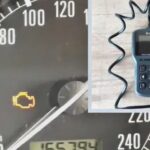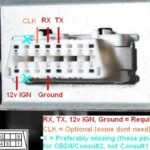For automotive enthusiasts and professionals using HP Tuners scanners, the versatility of OBD2 connectivity is a major advantage. However, a common question arises: can you connect multiple OBD2 devices, particularly scanners, at the same time without encountering issues? While seemingly convenient, attempting to use multiple OBD2 scanners, especially with tools like HP Tuners, can lead to complications due to the fundamental way OBD2 communication is structured.
The primary challenge stems from the OBD2 protocol itself. Most OBD2 systems, particularly in older vehicles, utilize a serial communication protocol. This means data is transmitted sequentially, like a single lane road. Only one device can effectively transmit data at any given moment. While connecting multiple scanners for basic diagnostic reads might appear to function initially, it’s far from ideal and can quickly become problematic, especially when you need reliable and rapid data.
Consider the SAE J1850 protocol, prevalent in older General Motors vehicles. With J1850, a scanning device must constantly request information. There isn’t a continuous data stream; instead, each piece of data needs to be actively solicited. This request-response nature, combined with J1850’s relatively slow data transmission rates (10.4 or 41.6 kB/s), means the more parameters (PIDs) you request to monitor, the slower the update frequency becomes.
Now, introduce a second scanner into this equation. This additional device will also start sending its own data requests. Not only does this further congest the communication channel, consuming valuable bandwidth, but the second scanner is unlikely to recognize or utilize data already being transmitted to the first. This results in redundant requests for the same information, needlessly clogging the OBD2 bus and significantly slowing down data retrieval for both devices. Imagine two people trying to talk at once on a walkie-talkie – neither gets their message across clearly or quickly.
Alt text: A close-up view of an OBD2 port in a vehicle, highlighting the pins for data communication, illustrating the physical interface for scanner connections.
While slow scanning can be frustrating, the real danger of multiple OBD2 devices emerges when attempting to program the Powertrain Control Module (PCM), a critical operation often performed with HP Tuners for vehicle tuning and performance adjustments. The exact PCM flashing protocols are OEM-specific and complex, but there’s a significant risk involved. It’s highly probable that after the initial command to begin the flashing process is sent by the primary HP Tuners scanner, any subsequent data requests from a second connected device could be misinterpreted by the PCM as part of the flashing instructions.
If this occurs during a PCM write operation, you could potentially overwrite the PCM’s operating system with corrupted or unintended data. This scenario could “brick” the PCM, rendering it unusable, potentially requiring costly replacement or specialized recovery procedures. The only safeguard against this would be if the OBD2 flashing code were stored in non-erasable read-only memory, which is not a standard expectation in automotive PCM design.
In conclusion, while the OBD2 system might tolerate multiple scanner-type devices to some degree, it’s fundamentally not designed for simultaneous multi-device operation. For optimal performance, especially when using HP Tuners for scanning and tuning, it is strongly recommended to use only one scanning device at a time. If data needs to be shared with other devices, it’s best practice to collect the data with a single scanner and then transfer or share that data externally. This approach prevents unnecessary strain on the OBD2 bus and, crucially, avoids potentially catastrophic issues during PCM flashing.
Important Note: Vehicles equipped with Controller Area Network (CAN) bus systems for OBD communication, common in newer models, are generally less susceptible to scanning speed reductions when using multiple devices due to the CAN bus’s higher data transmission speeds and more efficient communication architecture. However, the risks associated with PCM flashing while multiple devices are connected remain a serious concern even with CAN bus systems. Always exercise caution and prioritize single-device use when performing critical operations like PCM flashing with HP Tuners.

